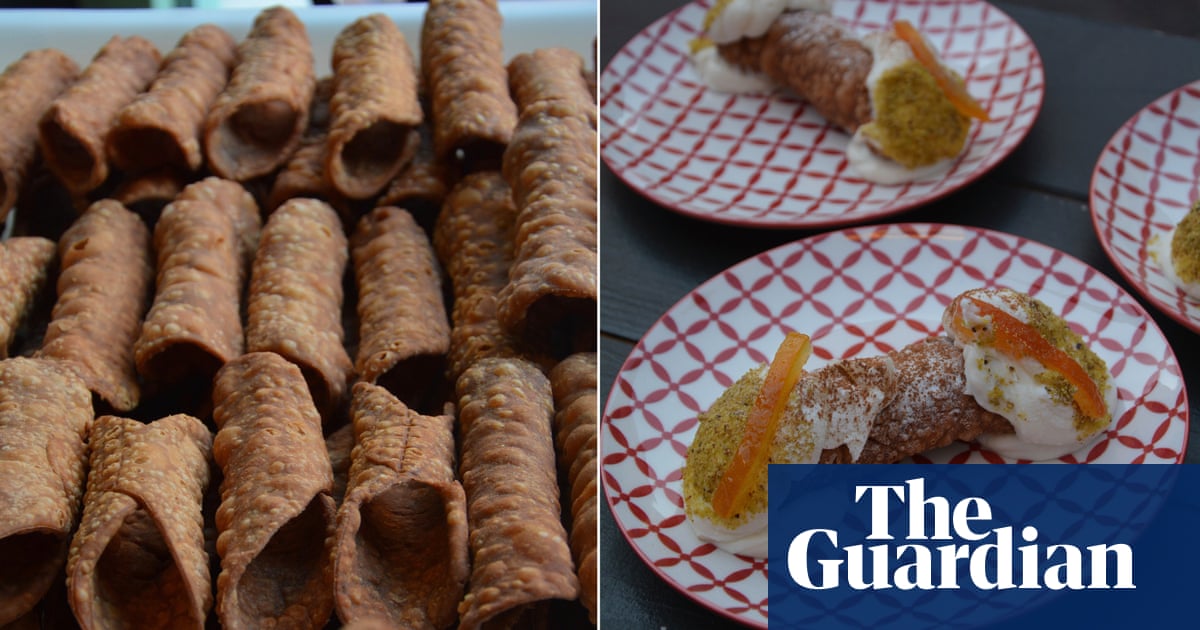The perennial Sicilian favourite confection, the recipe straight from the kitchen of a master of the art

After two disappointments, it was a relief to arrive in Comiso, south-west Sicily, to find that Cantunéra had not closed or been renovated beyond recognition since our last visit two summers ago. Parking has not changed either; it is tricky in the meandering centre. Then, when you do find a spot, it is often so awkward that getting into it is like trying to lever a hot foot into an undersized shoe. Eventually we park by the Aragonese castle and walk back towards the main square of the town before turning right into Via Giuseppe Di Vita and the reason we have come here: dinner.
I have written about Sandro Pace before; his progress from 11-year-old bar boy (to keep him out of trouble) to 17-year-old owner of bar Corallo; his training as a pastry chef in Ragusa then return to Comiso to open Cantunéra. I have written about his exceptional arancine, but this time I have come for cannoli.
The name cannolo comes from canna, the short length of cane the dough was traditionally wrapped around to form a tube, which was then fried and filled with sweetened ricotta. Apparently, cannoli evolved during Sicily’s Arab occupation, in a harem in Qal‘at al-Nisa (now Caltanissetta) where women made Roman carnival sweets their own, with phallic implications. The Arab domination ended, but cannoli did not. Not averse to certain habits, Christian nuns adopted the tradition of cannoli, which in time became ubiquitous in Sicily and beyond.
There are various well-known dramatic scenes in which cannoli play a part, the most poignant being in an episode of Sicily’s greatest and grouchiest Inspector Montalbano. Specially written after the death of actor Marcello Perracchio, who played doctor Pasquano for 15 years, the scene is set after the funeral: Montalbano calls colleagues into his office and hands each of them a cannolo. They eat in silence, an edible last curtain call to the cannoli-loving doctor and much-loved actor. It is a scene with new significance following the death of Montalbano’s writer Andrea Camilleri; sweetness as consolation. My Sicilian partner remembers cannoli from childhood, and packs of coffee being brought around during periods of mourning, when the body would be in the living room and everyone sat around eating cannoli and weeping.
Back at Cantunéra, Sandro credits signor Marino, a granita maker, as the person who taught him to value the best ingredients. He is visibly distressed as he tells us about what he sees as the lack of care and respect for ingredients many bars and restaurants in Sicily seem to have, and their resistance to change. He says he owes his skill and dedication to a rigorous training under Gino Malandrino in Ragusa; his kitchen is immaculate, with everything laid out ready to show me. He proudly reminds me that this is his own recipe for cannoli, and that there are many.
Never buy a cannoli that’s been sitting ready-filled is Sandro’s advice. The tubes should be piped full of sweetened ricotta for each customer on demand, otherwise they get soggy. Both ends of the tube are then dipped in ground pistachios and decorated with a curl of candied orange or some red or blackcurrants.
There are a few seats inside Cantunéra, but the best ones are on the pavement opposite. The impossible heat of the day has been replaced by a flirty breeze. While we sit, someone parks a car in an impossibly small space. Sandro’s cannoli don’t so much crunch as shatter between your teeth, giving way to the filling. It’s rich not just with ricotta and sugar, but with celebration, sex, abstinence, detectives and writers, life and death. In short, it’s sublime. We eat in silence.
Cannoli
You will need 10-12 cannoli tubes, and ideally a pasta rolling machine.
Prep 30 min
Chill 6 hrs
Cook 10 min
Makes 10 – 12
500g 00 flour
50g butter
50g caster sugar
7g salt
150ml red wine (ideally syrah)
50ml rum
1 orange, zested
1 pinch cinnamon
1 egg, beaten
Sunflower or peanut oil, for frying
For the filling
500g ricotta
125g icing sugar
Candied orange peel,for decorating
Pistachios,finelychopped,fordecorating
Put the flour, butter, sugar and salt in the bowl of a mixer and turn it on. As the mixer runs, add the wine, rum, zest and cinnamon, then let it continue mixing for 10 minutes. Wrap the dough in clingfilm and chill for six hours.
Using a pasta machine on the second-to-thinnest setting, roll the dough through and lay it on a floured board. Using a five-inch (about 12cm) cutter, cut it into rounds, then wrap each one around a cannoli tube. Seal with a dab of beaten egg.
Bring a pan of sunflower or peanut oil to 180C. Lower the tubes into the oil a few at a time and nudge them around until they’re golden and erupt into bubbles – 60-90 seconds. Lift them out and blot on kitchen paper. Once cool, slide the cannoli off the tubes.
Mix the sieved ricotta and icing sugar, then scrape into a piping bag. When it is time to eat, pipe the filling into the tubes, then dip each end in the chopped pistachios and decorate with a curl of candied orange.
Read more: www.theguardian.com









![[Video] How to get rid of bed bugs in Toronto](https://www.thehowtozone.com/wp-content/uploads/2019/10/maxresdefault-2-100x70.jpg)


